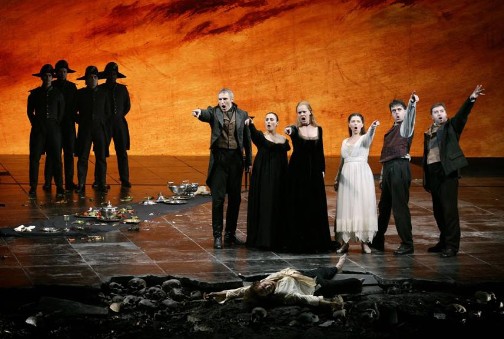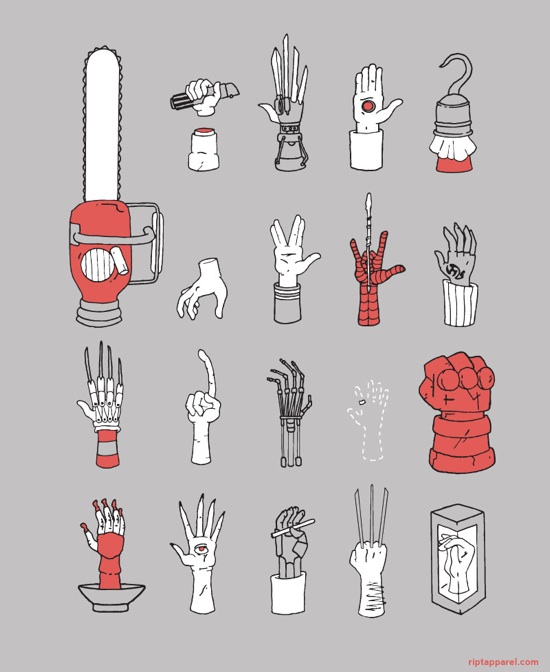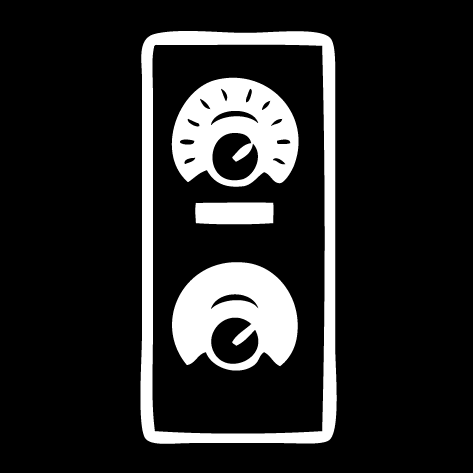Wittgenstein
Visualizing everything (part one)
On 25, Feb 2010 | No Comments | In space, visualization | By Dave
Not “everything” as in one-at-a-time, but as in everything at once. Macro. Meta. Big.
This first picture is a visualization of the entire history of the universe, recently produced by the WMAP space probe. WMAP’s mission is to listen to the faint reverberation that is still bouncing around since the Big Bang. Analysis of the WMAP data gives us a information not only about the size of the universe, but also its size over time. Here’s what it found.
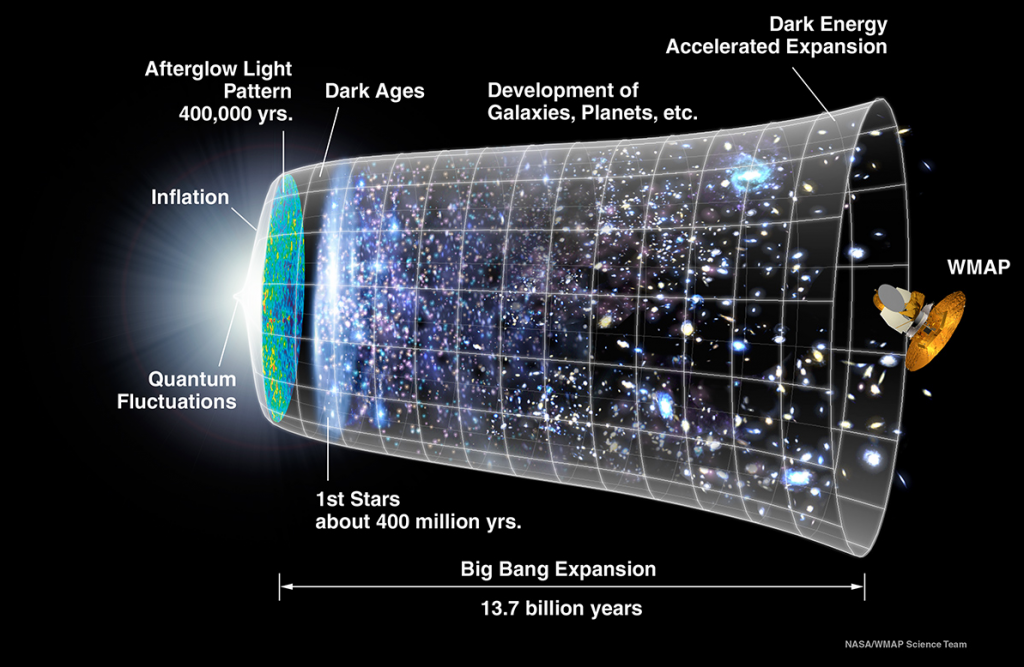
Time moves along the horizontal axis, and the size of the universe surrounds the vertical axis. It’s interesting to note that to express the size of the universe, you only need a single up-slanting line (the top edge of the cone), but in this image the line is wrapped around the horizontal axis to generate the cone structure you see. It associates the linear measurement of “size” with our idea of three-dimensional “space”. I think this visualization device works well to make the calculated size of the universe seem more tangible and real.
Now we have some idea of what the universe looks like over time. But if you disregard time and ask, what does the very largest superstructure of the visible universe look like?
Our best science says it looks like a giant morsel of luminescent bread.

It also looks strangely like a neural network, as my friend Aram pointed out. The spindles you see are billions of galaxies clumped and stretched together, called “filaments.” The dark spots are empty spaces containing nothing, called “voids,” and they have diameters of many bajillions of bajillions of whatever unit of distance you like. (Why the cube? I searched for a while and couldn’t find an explanation.)
Here’s a similar image, with map labels.

If you zoom in far enough to see (incomprehensibly giant) galaxies as single pixels, this is what you get.

How did mere humans come up with these images? They took Wittgenstein’s timeless advice: “Don’t think, look!”
Now we can visualize—we can appreciate—the magnitude of the two familiar dimensions of experience, space and time. The result is profound awe; there is really no other reaction one can have to the above images. On the other hand, these images don’t speak to the phenomenology of experience. They don’t depict the thoughts and processes that comprise our mental lives. For that we are going to need visual philosophy, which I’ll post about soon.
The meaning of ‘most’
On 03, Dec 2009 | No Comments | In language | By Dave
William Shakespeare, who knew a thing or two about words, advised that “An honest tale speeds best, being plainly told.” But the exact meaning of plain language isn’t always easy to find. Even simple words like “most” and “least” can vary greatly in definition and interpretation, and are difficult to put into precise numbers.
Until now.
Thrilling!
In a groundbreaking new linguistic study, Prof. Mira Ariel of Tel Aviv University’s Department of Linguistics has quantified the meaning of the common word “most.” [The study] “is quite shocking for the linguistics world,” she says.
“I’m looking at the nature of language and communication and the boundaries that exist in our conventional linguistic codes,” says Prof. Ariel. “If I say to someone, ‘I’ve told you 100 times not to do that,’ what does ’100 times’ really mean? I intend to convey ‘a lot,’ not literally ’100 times.’ Such interpretations are contextually determined and can change over time.”
I’ve noticed that I exaggerate modally—I choose a number and run with it for a while. Currently it’s 5, as in, “I’ve told you 50 times; I had to wait for five hours.” I don’t mean some specific number, I just mean to use it as a placeholder for exaggeration purposes. There must be a term for this. Linguists?
When people use the word “most,” the study found, they don’t usually mean the whole range of 51-99%. The common interpretation is much narrower, understood as a measurement of 80 to 95% of a sample — whether that sample is of people in a room, cookies in a jar, or witnesses to an accident.
So many problems are caused when we try to communicate with words about whose meaning we think we agree when actually we don’t agree at all. But Professor Mira Ariel is helping sort it out by empirically determining what it is that we mean. Wittgenstein showed that the meaning of words cannot extend beyond how they’re used. So empirical studies like this one can help us immensely. I’m betting this kind of research will also help artificial intelligence research.
“‘Most’ as a word came to mean “majority” only recently. Before democracy, we had feudal lords, kings and tribes, and the notion of “most” referred to who had the lion’s share of a given resource — 40%, 30% or even 20%,” she explains. “Today, ‘most’ clearly has come to signify a majority — any number over 50 out of a hundred. But it wasn’t always that way. A two-party democracy could have introduced the new idea that ‘most’ is something more than 50%.”
I can’t tell from this short article whether Professor Ariel has done research to support her assertion that modern democracy really is the source for the lexical definition of “most” as meaning between 51% and 100%. But if true it’s pretty interesting because it shows that the word “most” may be political—that is, an expression of power or authority—rather than geometrical or mathematical, which is what I had always assumed.
Here’s the full article.
Tactility in the Tractatus Logico-Philisophicus
On 01, Jul 2009 | No Comments | In books | By David Birnbaum
I’ve written before about the later writings of Wittgenstein and the metaphor of the word as a manual tool. However, in Ludwig’s first published work, the Tractatus Logico-Philosophicus, his theory of language is that sentences represent states of affairs, the so-called picture theory of language. Although he later abandoned that viewpoint for the tool-based one, I was intrigued by this historically significant switch-up, so I read through the Tractatus with special attention to its visual and tactile metaphors. Here are a few examples.
2.013
Each thing is, as it were, in a space of possible states of affairs. This space I can imagine empty, but I cannot imagine the thing without the space.
2.0131
A spatial object must be situated in infinite space. (A spatial point is an argument-place.)
A speck in the visual field, though it need not be red, must have some colour: it is, so to speak, surrounded by colour-space. Notes must have some pitch, objects of the sense of touch some degree of hardness, and so on.
This is a prime example of a sensory metaphor used throughout the book. Objects are described in a visual way, as being seen as situated within a possibility space or belief space. They themselves have extension, but we perceive them as taking up some amount of the visual field (surrounded by context, which here is represented as other possibilities for their position or physical attributes).
2.151
Pictorial form is the possibility that things are related to one another in the same way as the elements of the picture.
2.1511
That is how a picture is attached to reality; it reaches right out to it.
2.1512
It is laid against reality like a measure.
2.15121
Only the end-points of the graduating lines actually touch the object that is to be measured.
Again we get a visual metaphor described in terms of physicality. How is a picture “attached” to reality? It reaches out to it. And while it touches reality, it only just touches it, in a tangential way. Wittgenstein starts with a visual image and then writes “attached”, “reaches out”, “laid against”, and “touch”—all haptic metaphors.
2.1514
The pictorial relationship consists of the correlations of the picture’s elements with things.
2.1515
These correlations are, as it were, the feelers of the picture’s elements, with which the picture touches reality.
Now we have moved from the picture as a “measure,” a passive geometry tool, to a picture as an agent. Not just any agent, but an agent with a capacity for haptic perception. What is a “feeler”? To me that word means a mobile extremity with sense organs which can be used to find out about the world. So, what Wittgenstein seems to be saying here is that when we generate a picture in our mind, it’s as if we are extending our hand into the world.
4.002
…
Language disguises thought. So much so, that from the outward form of the clothing it is impossible to infer the form of the thought beneath it, because the outward form of the clothing is not designed to reveal the form of the body, but for entirely different purposes.
In other words, thoughts are like physical objects. A word envelops a thought. We have a thought and then we toss a word-robe over it and shove it onto the stage of discourse where it can interface with other enrobed thoughts.
4.411
It immediately strikes one as probable that the introduction of elementary propositions provides the basis for understanding all other kinds of proposition. Indeed the understanding of general propositions palpably depends on the understanding of elementary propositions.
Once again, a tactile metaphor (“palpably”) is used for emphasis and to indicate comprehensive understanding.
5.557
…
What belongs to its application, logic cannot anticipate.
It is clear that logic must not clash with its application.
But logic has to be in contact with its application.
Therefore, logic and its application must not overlap.
I.e.,

Is “overlap” a haptic metaphor or a visual one? It could be either, or both.
6.432
How things are in the world is a matter of complete indifference for what is higher. God does not reveal himself in the world.
6.4321
The facts all contribute only to setting the problem, not to its solution.
6.44
It is not how things are in the world that is mystical, but that it exists.
6.45
To view the world sub specie aeterni is to view it as a whole—a limited whole.
Feeling the world as a limited whole—it is this that is mystical.
To feel is to know, silently, mystically.
I was pretty surprised at how easy it seems to foresee Wittgenstein’s turn from the eye to the hand. He presents what he calls a picture theory of language, but it repeatedly leads to a description of solid objects in space, or bodies moving and feeling and contacting each other. Of course I’m reading with a very biased perspective. Not only is my goal to hunt for tactile metaphors but I also know how the story ends some 30 years later. Still, I can’t help but feel that the tactile language in the Tractatus may foreshadow the shift to come.
Philosopher deathmatch, and how words are like tools
On 07, Sep 2008 | No Comments | In books, language, tactility | By David Birnbaum
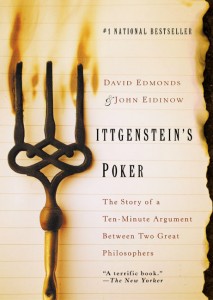 I just finished reading Wittgenstein’s Poker. From the jacket:
I just finished reading Wittgenstein’s Poker. From the jacket:
In October 1946, philosopher Karl Popper arrived at Cambridge to lecture at a seminar hosted by his legendary colleague Ludwig Wittgenstein. It did not go well: the men began arguing, and eventually, Wittgenstein began waving a fire poker toward Popper. It lasted scarcely 10 minutes, yet the debate has turned into perhaps modern philosophy’s most contentious encounter, largely because none of the eyewitnesses could agree on what happened. Did Wittgenstein physically threaten Popper with the poker? Did Popper lie about it afterward?
The authors provide a comprehensive biographical and historical context for the incident, and use it as a springboard into the two men’s respective philosophies. It’s an enjoyable look at two self-important, short-tempered intellectuals and their rivalry.
As I mentioned in this post, I find Wittgenstein’s philosophy of language often invokes touch themes. In the following excerpt from Poker (originating from one of his lectures), Wittgenstein makes a point about a colleague’s statement, “Good is what is right to admire,” utilizing a haptic metaphor:
The definition throws no light. There are three concepts, all of them vague. Imagine three solid pieces of stone. You pick them up, fit them together and you now get a ball. What you’ve now got tells you something about the three shapes. Now consider you have three balls of soft mud or putty. Now you put the three together and mold out of them a ball. Ewing makes a soft ball out of three pieces of mud. (68)
Another example stems from Wittgenstein’s midlife change in philosophical outlook. In his first publication, the Tractatus Logicio-Philosophicus, he was preoccupied with the “picture theory of language”—the idea that sentences describe “states of affairs” that can be likened to the contents of a picture. Later, he developed a theory of language based on words as tools for conveying meaning. In my reading, he shifted from a vision-based to a haptic-based (in fact, a distinctly physical-interaction-based) understanding of how language works.
The metaphor of language as a picture is replaced by the metaphor of language as a tool. If we want to know the meaning of a term, we should not ask what it stands for: we should instead examine how it is actually used. If we do so, we will soon recognize that there is no underlying single structure. Some words, which at first glance look as if they perform similar functions, actually operate to distinct sets of rules. (229)
Here’s the relevant passage directly from Philisophical Investigations:
It is like looking into the cabin of a locomotive. We see handles all looking more or less alike. (Naturally, since they are all supposed to be handled.) But one is the handle of a crank which can be moved continuously (it regulates the opening of a valve); another is the handle of a switch, which has only two effective positions, it is either off or on; a third is the handle of a brake-lever, the harder one pulls on it, the harder it brakes; a fourth, the handle of the pump: it has an effect only so long as it is moved to and fro. (PI, I, par. 12)
Words as the physical interface to meaning. Love it!
Wittgenstein
On 28, May 2008 | One Comment | In books, tactility | By David Birnbaum
 The philosophy of Ludwig Wittgenstein seems to come up often, so I decided to read up on what all the hoopla is about. This semi-biographical introduction to his major works is fascinating and easy to read. It seemed pretty comprehensive as well, though I’m no expert.
The philosophy of Ludwig Wittgenstein seems to come up often, so I decided to read up on what all the hoopla is about. This semi-biographical introduction to his major works is fascinating and easy to read. It seemed pretty comprehensive as well, though I’m no expert.
Wittgenstein was primarily concerned with logic and language, but I found his emphasis on know-how as opposed to know-that, and his view that skill supersedes knowledge of rules, to have a certain ‘embodiment’ quality to it. Excerpts:
So, language can indeed be said to be governed by rules; but those rules are for the most part only implicit in native speakers’ common usage. They can be derived from common usage by anyone who pays attention to it, but they are rarely operative in it: we do not normally use rules to work out what is correct. Rather, we have a fairly reliable ‘feeling’ for what sounds right in a given case. Rules can be formulated to codify our usage, but our usage is not ultimately based on such rules. (191)
Our traditional concept of pain, however, is not in competition with concepts that classify the same phenomena in terms of their underlying conditions. No physiologist could convince me that what in my own case I call ‘pain’ may not in fact be pain, or that my pain was in truth not where I felt it but in the brain. Why is this so?
Concepts are an expression of our interests. We group things together and call them by a common name according to those resemblances we find striking or important. And in different contexts we may be interested in different aspects of things. To classify phenomena scientifically, by their underlying structures or causes, is not always what we want. For instance, when taking an aesthetic attitude towards things, we are concerned entirely with their appearances. Invisible micro-structures become wholly irrelevant. And another area in which the scientific urge to leave behind the surface for underlying causes is often out of place is the realm of feeling: where our primary interest is in people’s conscious experience. Their suffering and well-being is important to us in its own right, and not merely as an indication of some underlying physiological conditions. Therefore physiological concepts like ‘lesion of tissue’ — whatever their importance for diagnosis and therapy — can never be in competition with, or act as substitutes for, our traditional concepts of feelings and emotions that are taught and understood through their links with natural expressive behaviour and characterized by the special authority we have in their first-person use. (254)
